Hatsune Miku Suffers From Laryngitis in the Digital Void: A Review of Colorful Stage! The Movie

You’ll probably have noticed that the first ever feature film to feature beloved virtual idol and cultural icon Hatsune Miku is not called Hatsune Miku The Movie.
It is instead, called:
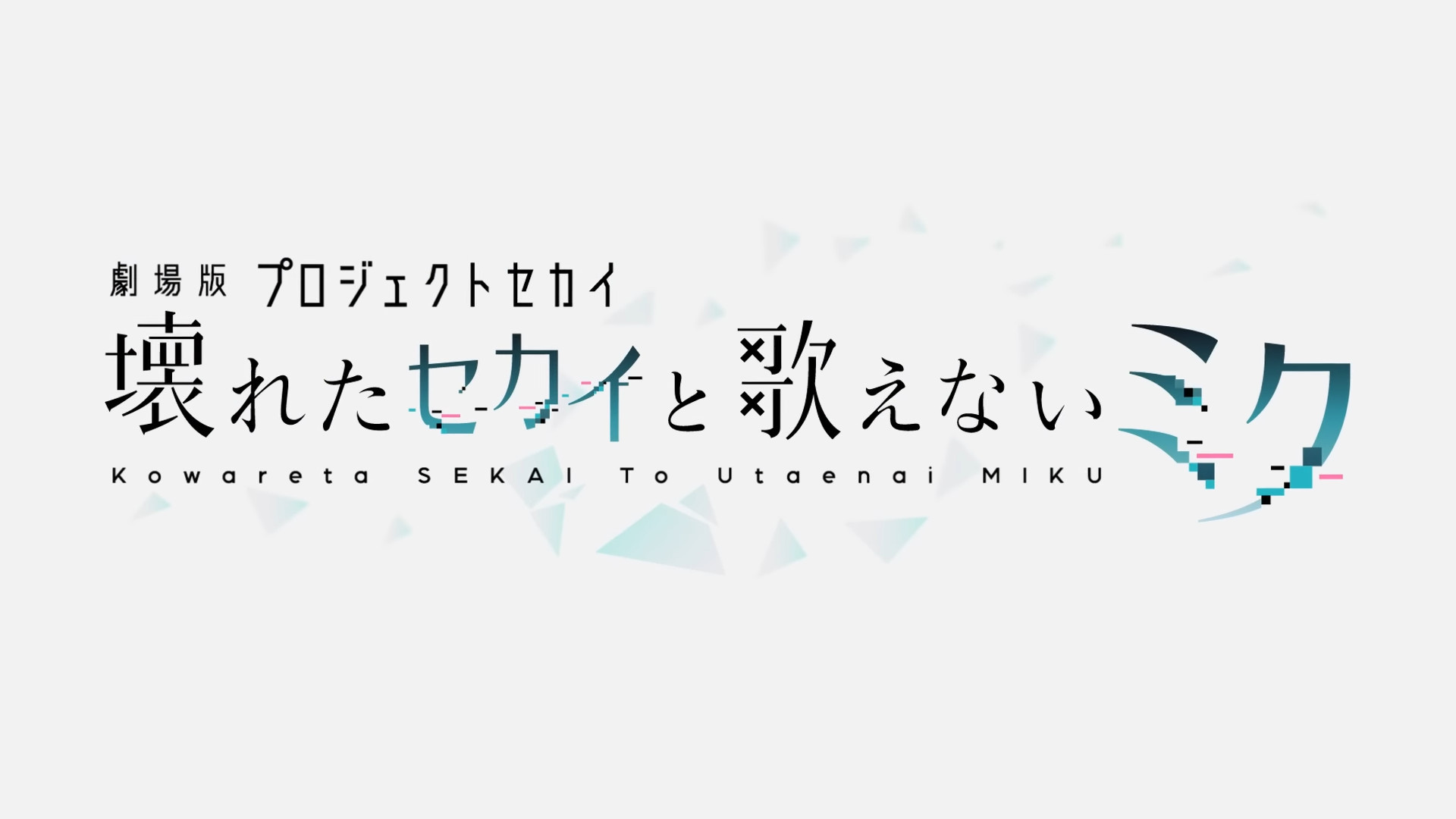
Gekijōban Purojekuto Sekai Kowareta Sekai to Utaenai Miku.
“The Movie of Project Sekai: Broken SEKAI and Voiceless Miku.”
Which was fairly loosely localized as:
Colorful Stage! The Movie: A Miku Who Can’t Sing.
Dropping the “Broken SEKAI”, cough, "world," part, to avoid confusing people who just want to see the Miku movie and don’t know what the hell the trademarked and patented all-caps SEKAI is, but overall preserving the overall sentiment of the title. It is “Project Sekai-” ahem “Colorful Stage, The Movie.” It clearly communicates that it is based on this video game, and Miku doesn’t come into play until the subtitle. Much as is the case with the game itself. It’s not “Hatsune Miku’s Project Sekai”, it’s “Project Sekai… Featuring Hatsune Miku!”.
…Well, in Japanese, at least. The English title of the game puts Miku’s name first, which, y’know, makes sense for marketing to people who know who Miku is but didn’t necessarily play Project Diva, but, anyway-
point being, this movie works best if you know and care about that game. If you don’t know anything about the game and just want to see Miku, well... your mileage may vary, but you’ll probably be at least a little confused. Hatsune Miku is very much the protagonist of this film, and the structure of the movie is not complex, but it shares its setting and entire supporting cast with the video game and does not clearly explain how any of it works or who any of these people are. The movie doesn’t demand encyclopedic knowledge of the game or anything, but if you don’t at least already know the premise and the cliffnotes summary of all the characters, you will have a lesser experience.
“so is the movie good?”
that depends on you. If you love Project Sekai, yeah, of course it’s good. If you just love Hatsune Miku? I dunno. maybe. If you don’t love either and aren’t, like, a deeply emotionally repressed Hatsune Miku enjoyer, then probably not. but maybe you should, like, make up your own mind about that.
Personally, I’d have to admit that this movie is, if I try to put aside my attachment to the source material and evaluate it reasonably critically, dare I say with an eye towards attempting the mythical (and impossible) holy grail of critical objectivity... somewhere around a 6.5 or maybe 7/10 at best.
Still, I fucking loved it.
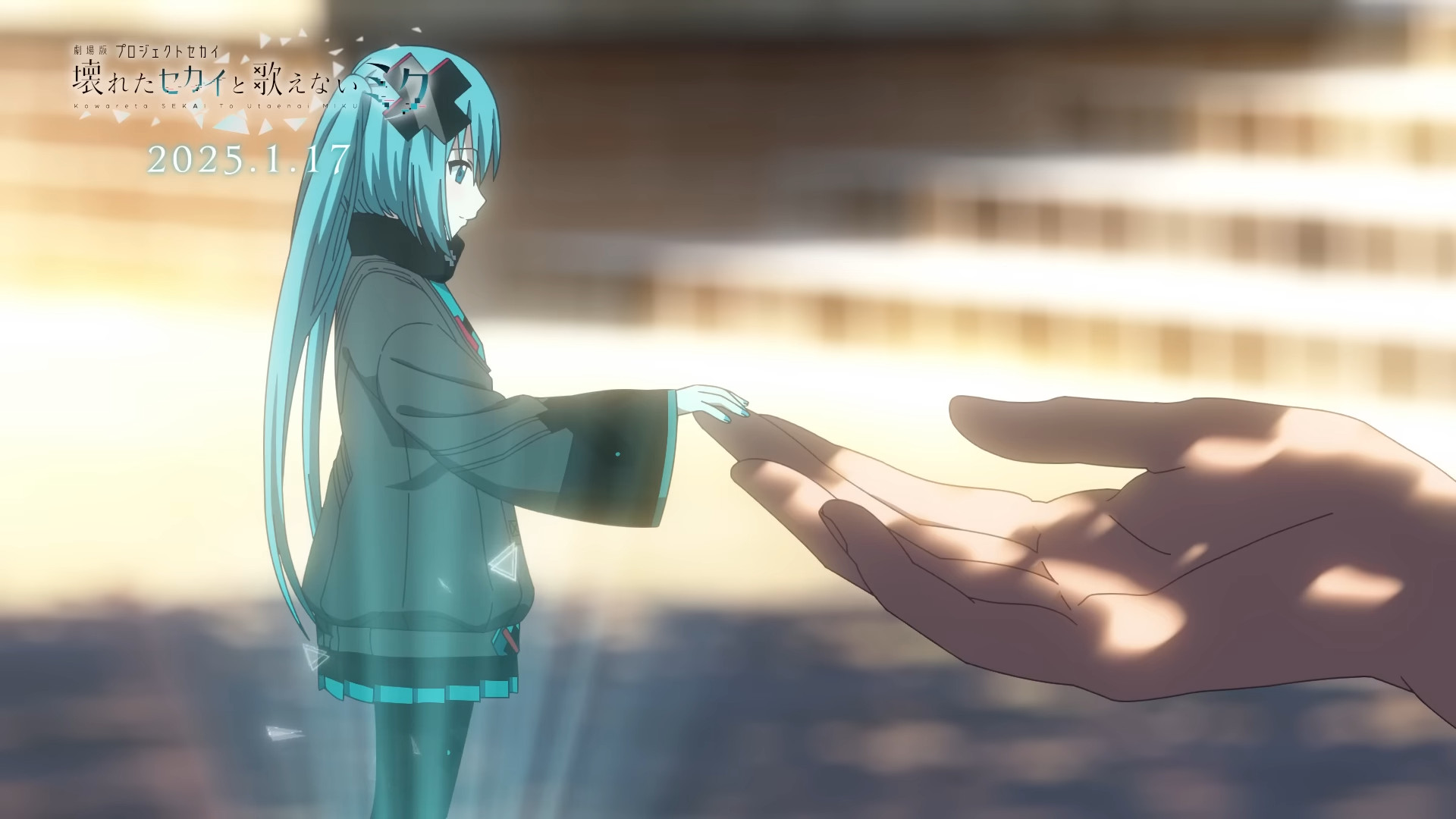
The Disappearance of Hatsune Miku is definitely no Disappearance of Haruhi Suzumiya. Still, for a fan of the source material, it’s very satisfying.
As with almost any adaptation whose appeal derives at least partially, in whole or in part, from being “The New Thing of The Thing!”, there is a great amount of pleasure to be taken from seeing the characters you know from one medium being faithfully brought to life in another. Much has already been said about the merits of adaptations of video games to other mediums, particularly when video games themselves so often already resemble or even directly incorporate film and animation without needing to be adapted directly to those formats. I find that this conversation usually misses that, one, not all video games are the same, and two, not all adaptations of video games are the same. Some games aren’t trying to be playable films or cartoons, or are limited in one respect or another by their chosen genre.
Project Sekai, as a rhythm game paired with a perpetually updating visual novel where the characters are primarily expressed as either 2D illustrations, 3D models with limited facial articulation, or live2D-rigged sprites limited mostly to a collection of canned animations, is visually limited in a lot of obvious and non-trivial ways. Consequently, there is much joy to be derived, as a fan of the game, out of seeing Project Sekai’s huge cast of characters being fully animated and doing their things. Seeing actual anime scenes of the game’s five groups, and not just live2D sprites with dialogue describing them doing stuff, is a real treat.
Scenes like Minori with her dog, Kohane with her snake, Mizuki shopping for her favorite designer clothes, Mafuyu looking through her aquarium, Emu doing her fun energetic little dances, Ichika doing street performances and chilling in her room listening to Miku songs with her Miku plushie(!!!), Kanade visiting her amnesiac dad in the hospital, Ena and Akito exchanging their usual biting sibling rivalry quips, Shizuku being a not-so-secret siscon, An working at her dad’s cafe, Rui eccentrically directing Wonderlands x Showtime’s whimsical shows, and so on— it’s all really great. I was positively alight with excitement in the theater at seeing all these moments, in both viewings. And the movie is fully committed to making sure that no fan of the game walks away feeling unsatisfied with the amount of screentime gotten by any particular character of group.
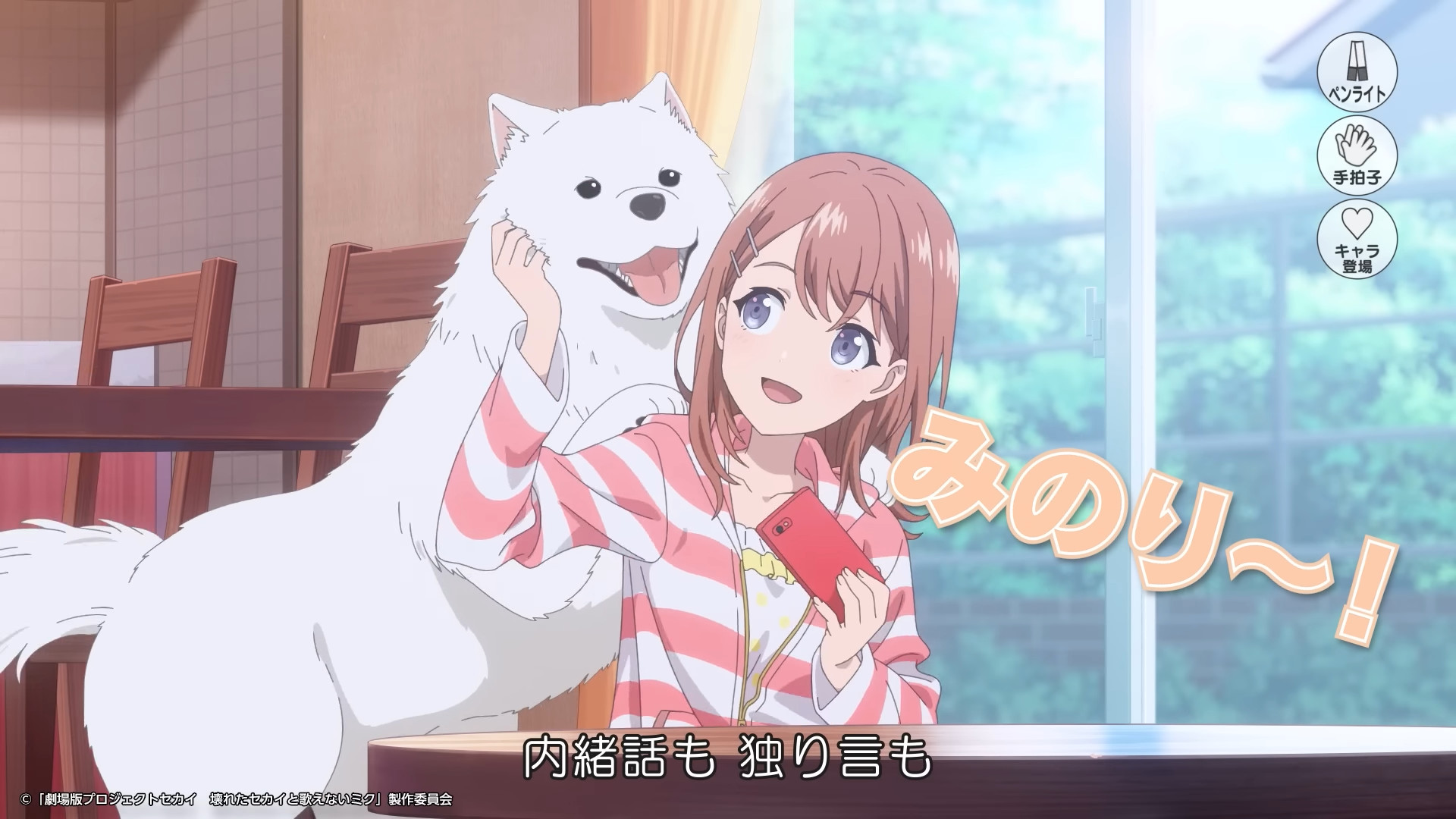
Now, obviously this basic level of fanservice (of the "look at that thing you know!" kind, not of the "look at boobs!" kind- not that I mind the latter kind...), the whole “look at the characters being animated!” appeal factor was already satisfied in the “Journey to Bloom” recap shorts, and also in the anniversary MVs, where we get a yearly dose of original animation showing us the highlights of the past year of the game’s narrative. But these are, y’know, clip shows that exist to promote the game, and much of the anniversary MVs are just whole shot references to gacha cards that already exist. Like, I’m not gonna pretend those aren’t nice and all, but they still aren’t, like, a full anime with the characters. So, the movie being announced was pretty exciting. Finally, a whole actual anime properly telling the story of the game and not just a promotional commission rehashing the best parts of what we already know in a manner incomprehensible to those who don’t already know!
And, having seen the movie at least twice by the time you’re reading this, and loved it all of those times, I can definitively, confidently say, that…
We still do not have that.
Now, I should clarify that I’m not speaking from a position of disappointment here. We knew, ahead of time, that this movie was not and could not possibly be a direct adaptation of any part of the game’s story, and it was made very clear from the moment of its announcement that it wasn’t. Still, the approach that this movie took to adapting the game gives rise to a lot of obvious issues.
For one thing, a not-insignificant portion of this movie is obviously going to confuse people who’ve never played the game before. Not because they won’t understand what’s happening, exactly- it’s a pretty simple plot that I can summarize pretty simply, and did summarize pretty simply on the Wikipedia article about the film. Still, I can summarize it even more simply right here:
ahem Hatsune Miku is sad, and a bunch of attitudinous, energetic, and passionate teens are called upon to cheer her up so that she can in turn bring cheer to the world.
Even though this plot is pretty simple, and the movie’s screenplay is about as straightforwardly structured in three acts as screenplays can be, the movie neglects to explain clearly who any of the characters are, let alone what SEKAI are or how they work. It very unashamedly assumes that you already know because you’ve already played the game, and if you haven’t, well, good luck figuring that out. It’s not too hard to infer the basics from context, but I can also imagine that you’ll spend a lot of time wondering who any of these people are and why you should care. However, even when you do know who they are, a bigger problem with this movie quickly rears its head:
The narrative pacing is, in my objectively subjective assessment, kind of dogshit.
I mentioned earlier about how the movie is committed to making sure no fan of the game walks out disappointed that their favorite group didn’t get enough screentime. And, yeah, it is very much so. Every group and character does get more or less an equal amount of screentime. However, because of the simple plot, a lot of that screentime is spent on each group independently reiterating their part of doing the plot at you.
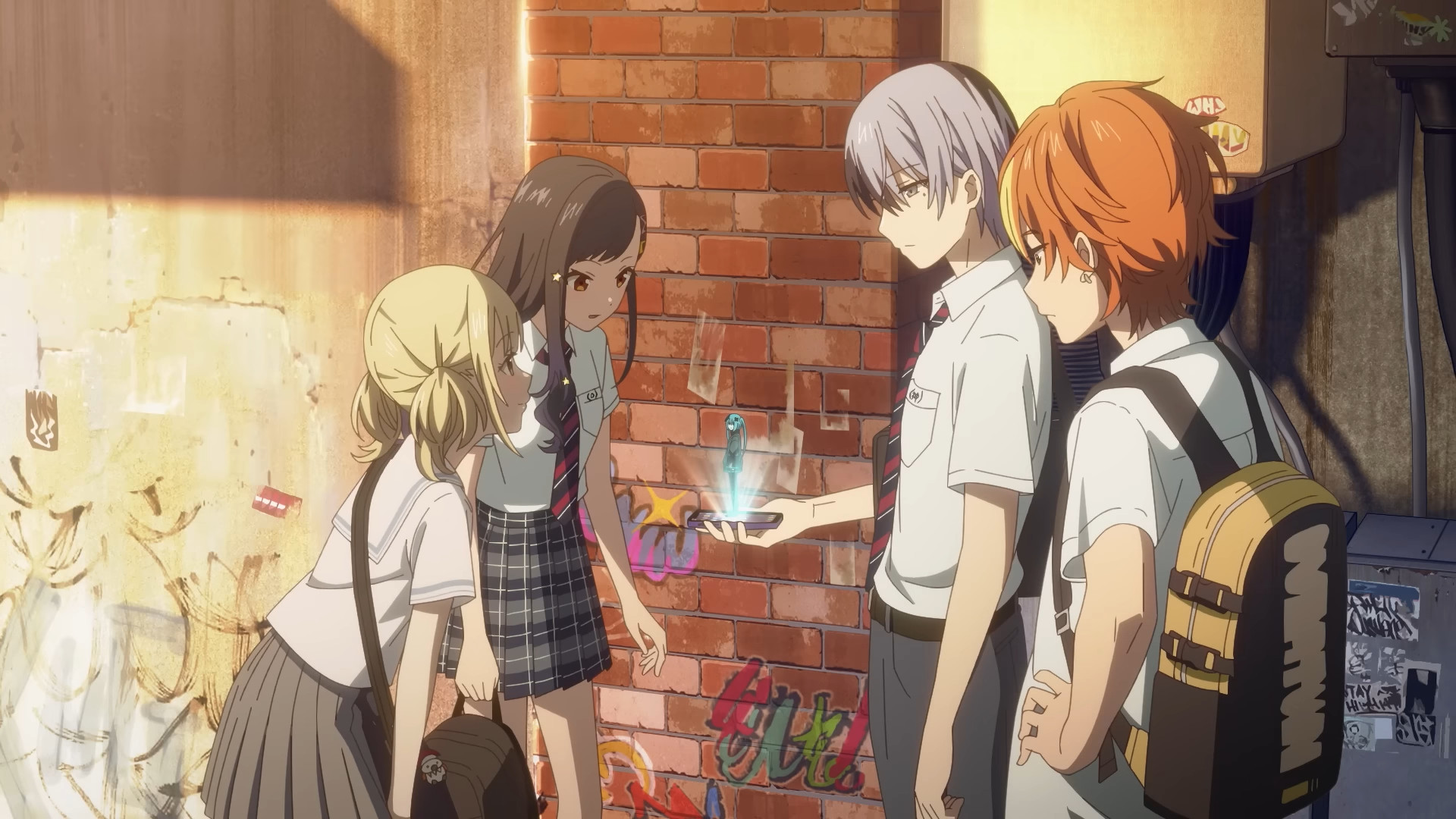
The groups collectively all have the same role in the plot- cheering up Miku- but because of the arbitrary plot limitation that they can’t, like, talk to each other about the SEKAI because none of the groups know about the other groups all having their own versions of Miku and friends, much of the film is spent on them independently doing the same thing, learning the same information, and coming to the same conclusions about how to solve the core conflict of the film. They all get a scene of meeting Miku, helping her figure out her song, saying the story’s themes at the camera repeatedly while clarifying how their own personal character arcs, y’know, the ones you know from the game you’ve played, are related to those overarching themes, and so on.
If you don’t know who they are and don’t get anything out of them talking about themselves, it will likely feel repetitive and tedious. Even I, knowing who they all are, started to feel like the movie was dragging a bit. Like, particularly with the scene of Leo/need on the rooftop when Ichika is like, “I felt just like the people whose feelings made that SEKAI when we all split up and I felt so lonely and listless-” and I was just kind of like… Yes! I know! I’m aware! I played the game, I read the story in the game, you don’t need to tell me what happened in the game!
So, yeah, it obviously doesn’t work on any level as an alternative to the source material, or even as a standalone story set in the same world. It’s not really an adaptation, it’s not even really a supplement, it’s just, like… another episode. It’s one of the game’s mixed-unit special event stories but on a much larger scale. It’s basically the gacha game equivalent of a movie based on a TV show that, sure, is called “TV Show: The Movie” but is in practice a Very Special Episode of the show with higher stakes than usual.
The movie does try to adapt the overall themes of the game, but, in this regard, I would argue it misses the mark. Like, yeah, it has the general overall theme of connecting to people through music, and that’s there, and it also has the game’s recurring theme of characters struggling with the tension between their dreams and harsh reality, but it doesn’t deal with this theme with any of the realism of the approach the game takes. Stay with me now.
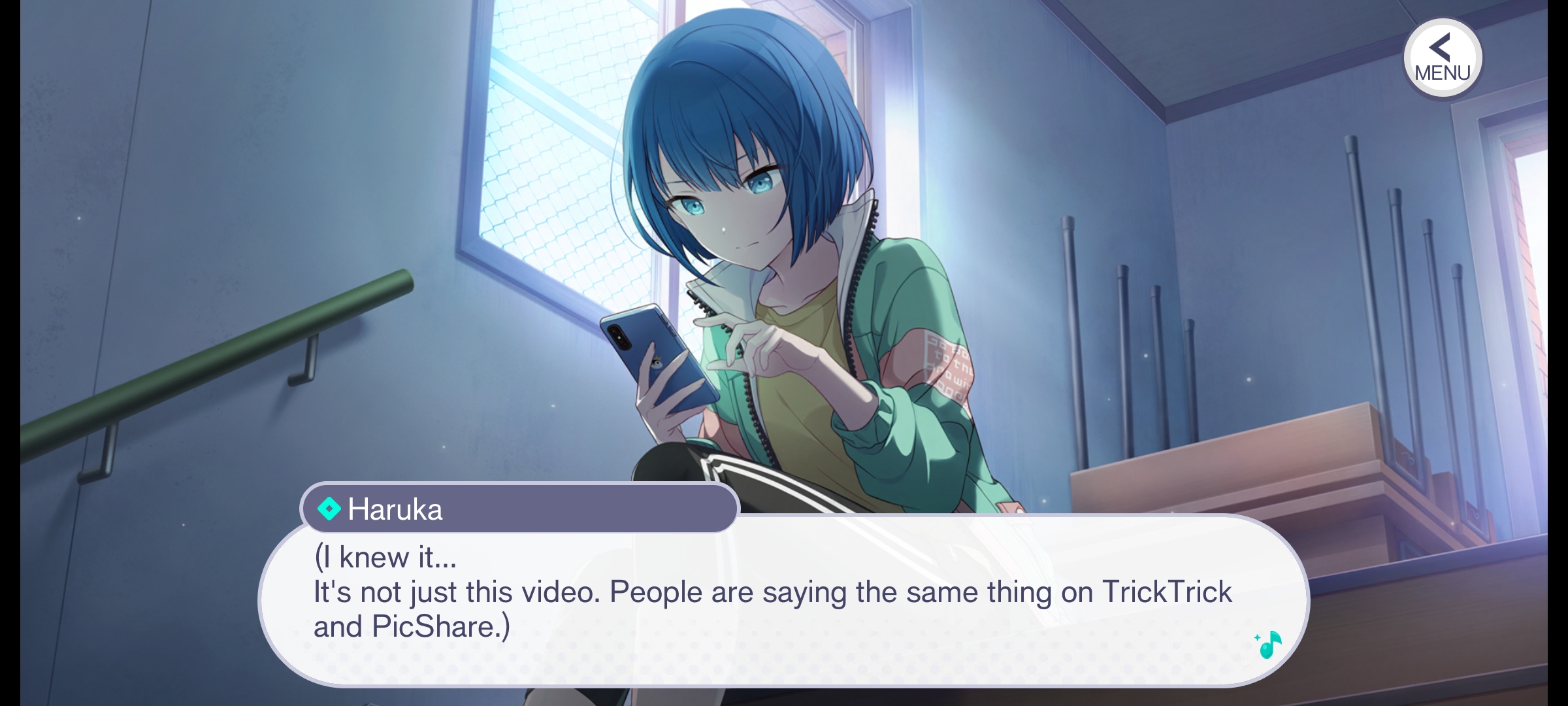
I don’t mean to imply that the game deals with this theme in an exactly realistic way- after all, this is a game where teenagers travel to the digital vocaloid dimension with their smartphones by pressing play on the magic song made from their true feelings. However, there is a non-trivial, if perhaps narrow, distinction to be drawn between magical thinking, and wishful thinking. Most of the vocaloids’ involvement in the game's drama basically begins and ends at giving advice. The onus to solve the conflicts still lies on the shoulders of the human characters in the real world, who have to actually work for their achievements and persuade others to help and support them. The conflicts often resolve conveniently, perhaps, but, y’know, it’s fiction. It’s fine for fiction to be convenient.
The game leans on wishful thinking. It says that, yes, music can bring happiness and inspire camaradarie, give them the courage to repair their relationships, achieve their ambitions, and solve their problems, but it is still people who have to work to solve their problems. The movie, though: magical thinking. Typical normal musical film magical thinking, really. The solution to the core conflict is nothing more and nothing less than singing. The key to healing the world lies in art.
This doesn’t make the movie bad, or anything. I can’t honestly say that I’m not susceptible to believing in a little romance for at least an hour or two. I’m a romantic girl at heart. It’s comforting to revel in the notion that I can save people and the world by being sweet and adorable and remarkably well-spoken. And, y’know, maybe I can save a couple people. I’d like to believe I have saved at least a couple of you at home out there, and that I can save at least a couple more. But, y’know, I’m not naive. I know that the extent of my ability is probably just being able to on occasion persuade some other girls to not kill themselves.
I’m just like Kanade for real, I guess.

So, yeah, this movie isn't my ideal Project Sekai anime. It was never going to be, but it's probably still worth talking about why it wasn't.
My ideal Project Sekai anime would be a full anime adaptation of, like, multiple TV seasons adapting all the main story arcs. Maybe not adapting all the mixed stories, but, y’know, adapting some of them, cause filler is sometimes good. Failing that, if they had to choose just one group, I’d obviously prefer they adapt the Niigo storyline, because, like, that shit is peak and needs to be done justice in a medium where it isn’t weighed down by monetization and inevitable gacha game obsolescence putting off a lot of the people most likely to appreciate it.
The reality is, though, that that’s probably never going to exist even in its most compromised potential forms. I mean, I can hope, though. The movie was apparently a commercial success, making good money in Japan where it released alongside the Gundam Gquuuuuux movie. So, who knows, they might make a more proper anime adaptation of the story sometime, if the suits at Sega and associated companies decide that that'd make them more money.
Although, even if we don’t ever get such an adaptation, at the very least we have Jellyfish Can’t Swim in the Night, or, Yorukura, which, at this point in time, is pretty much the closest thing to a proper Prosekai anime is existence, just because, uh, they're obviously taking inspiration, to put it lightly.
Yorukura’s pretty derivative of Project Sekai, generally. Its setting, aesthetics, and characters synthesize a lot of stuff that's obviously borrowed from it. There's the idol stuff, the online stuff, the street art and performance stuff. And then there's the way the cast obviously parallells Prosekai, but especially of the niigo storyline with how it, y’know, is about an anonymous music group posting their work online who have to navigate their interpersonal relationships and their burgeoning fandom and familial and social hangups. Kano is a mix of traits borrowed from Haruka and Shizuku and Mafuyu and An, Kiui is a variation on Mizuki but AFAB and leaning masc instead of AMAB and leaning femme, Kim is the Minori to Kano’s Haruka, and Mahiru is basically just Ena. I mean, it's obvious just from her design.
I’m not saying it's totally unoriginal. Being derivative isn't in itself a bad thing, and the criticisms I do have of Yorukura aren't really related to it being derivative of Project Sekai. I liked it a lot, and it mixes up a lot of new elements and has a lot of its own interesting things going on. Still, a lot of it really comes off as them wanting to capitalize on prosekai’s popularity, and also the fact that, like, its story is good and it makes some amount of sense to copy a good story that people like.
And, y'know, I appreciate that it is what it is. As a TV anime with a reasonably complete and contained story, it has a certain degree of freedom to toy with and remix its borrowed themes and story elements in a way that a direct explicit adaptation of the game’s story would never have. An actual anime adaptation of Project Sekai, would, with the limit of one 12 episode season, be forced to either drastically compress the pacing or else limit the scope of what gets adapted. Yorukura gets to more or less just be a complete TV anime that is like, this is a thing you can watch instead of playing Project Sekai if you don’t want a gacha game to consume your life.
So, until we get, like, an anime film tetralogy or something adapting all the main niigo arcs to a watchable format, this is definitely the closest thing to that. It's still pretty far from it, but, yeah.
…Anyway.
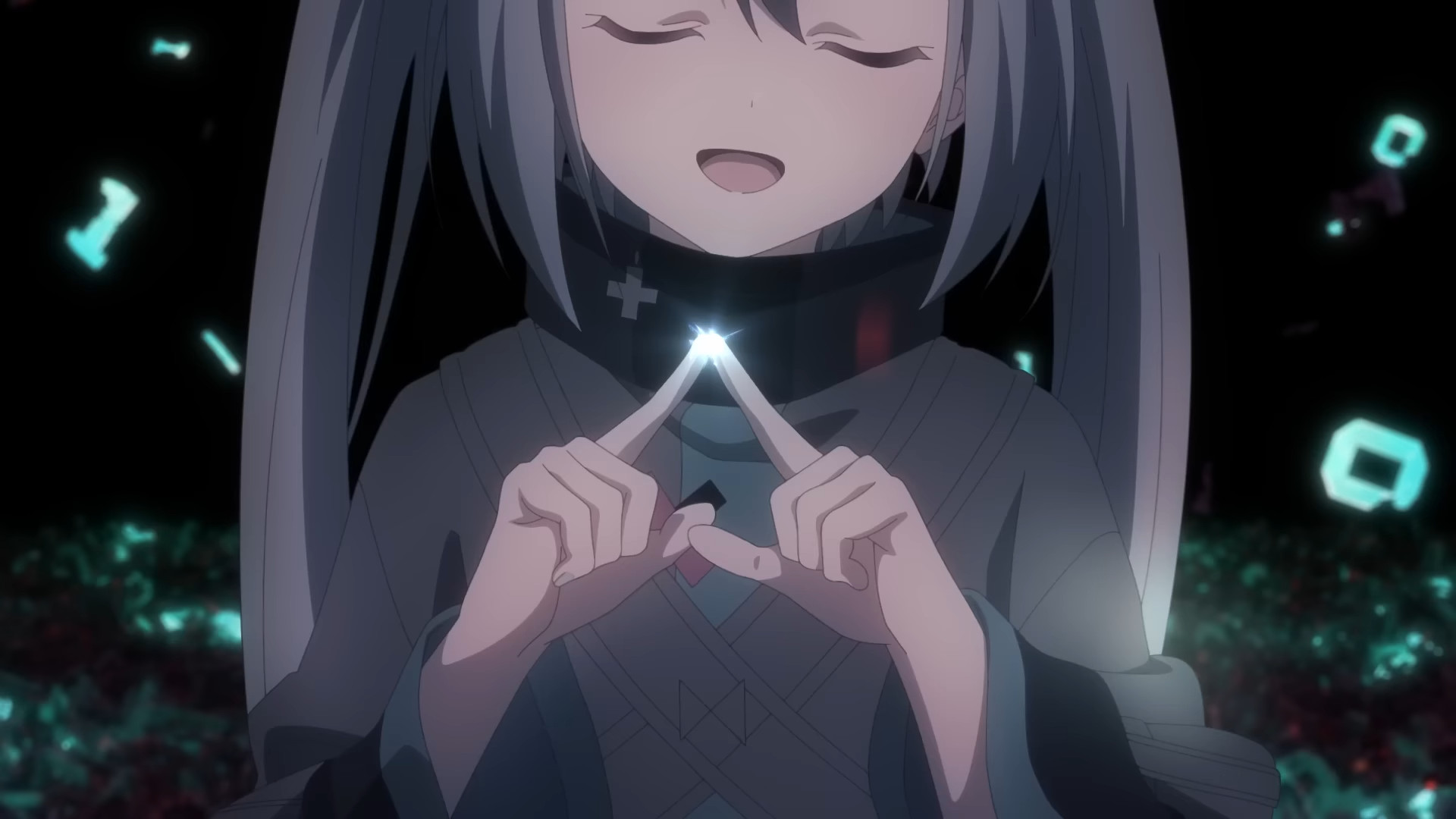
The movie might not be the ideal adaptation of Project Sekai, but you might be wondering,
Well, this is the first feature film, hell, the first actual ANIME, about Hatsune Miku! How is it as Hatsune Miku’s anime debut?!
Yeah, that’s true. It might not be called Hatsune Miku: The Movie, but this movie is not not The Hatsune Miku Movie. It definitely does its best to rise to that task.
As I said near the start of this essay, Hatsune Miku is the protagonist of this movie. She is very much not the protagonist of the phone game, where she’s a supporting character to the the 20 other characters who are the protagonists. But of course, the only way this movie could really work as a movie was reversing that dynamic. Game says: “You all know who Hatsune Miku is, now get ready to know these awesome rad teenagers with their dreams as Miku helps them!” Movie says: “You, game player, know who these awesome rad teenagers are with their dreams, now watch as they return the favor to Miku for helping them!”
The movie is structured more or less as an origin story for Miku, as this Miku learns how to become the Hatsune Miku, the one you all know, the one who smiles and sings for everyone and never gives up, the one with the blue hair and blue tie hiding in your wifi who’s on top of the world, and the world is hers. That one.

That’s, I think, the one aspect of the game that the movie successfully adapts: this setting’s particular approach to adapting Miku’s folklore. The idea that she’s an internet deity that can do anything who inspires hope in anyone who hears her voice. It’s a very loose mythology that allows anyone to play on it and make up their own Miku, and the game plays with that by giving all of the groups their own Mikus and having throwaway dialogue about how versatile Miku is, how she can be anything she wants and sing any song and inspire anyone. It’s a smart approach that lets the game have a little tonal range while also being, y’know, widely appealing and merchandisable.
And, y’know, someone at Sega is definitely kicking themselves for not having come up with Brazilian Miku first.
Project Sekai, as a franchise, is one of the many examples of a piece of media balancing its use of the folklore, imagery, and material it’s able to borrow from its relevant fandoms, with the need to relentlessly commercialize and promote, that have grown common in the internet age. It’s definitely one of the more fascinating examples of this, given that unlike something like, say, the Sonic the Hedgehog series, the vocaloid canon is basically built from the ground up on the work of the community. So, where a franchise like Sonic can just kind of borrow the fandom’s memes at will and roll with it, Project Sekai has to tread more carefully. It’s in their interest to maintain a good relationship with the fandom, because, y’know, the fandom makes the songs.
And the approach to this that they took within the context of Project Sekai’s setting is to more or less canonize not just Miku herself, not just her lore, but also the fandom itself. The musical groups all have their own Mikus, and they also, at least in theory, represent the wide breadth of songs that can be created with Miku and the diverse community of individuals making them. And this is played to an even greater extreme in the movie, where the new Miku that the movie’s plot follows is not just psychophysiologically bound to the emotions of a limited group of people who all know each other personally, but to, like, the populace of Shibuya.
And like, that’s all cool and stuff, but it does leave the movie in an awkward place. It’s relying on a lot of intertextuality, and it’s conflicted, because it’s trying to be the Hatsune Miku movie, and the Project Sekai movie, and it’s named for both, and it kind of does both and kind of does both of them pretty well but also it’s just not a good introduction to either.
Is this a bad thing? I don’t know. I mean, y’know, maybe my perspective is slightly skewed by that my girlfriend didn’t care about Miku or Prosekai and doesn’t like most Vocaloid music, and so I got to see directly that the movie just doesn’t work for the person who isn’t in tune with any of this intertextuality to any meaningful degree.
she described it, reasonably accurately, as an advertisement.
and, y’know, yeah. It is. Almost all anime is an advertisement to some extent or another, whether for games or manga or gunpla, but some anime are more advertisements than others, and this one is pretty far towards the pure advertisement side of the spectrum. This movie is, above all else, an advertisement for the mobile game and its gachas, but also for the image of Miku as a character that Sega and Crypton have spent around two decades cultivating, and also for the associated musical acts and albums that go with the franchise they’ve been building with it.
So,
Quick fact about me, I guess.
This may come as a surprise, but in general, I don't really like advertising. I think ads are often annoying, intrusive, bothersome, psychologically manipulative, and usually pointless. All the usual reasons you'd expect someone to not like ads.
However, about seven years or so ago, while visiting Tokyo (our parents put us there. it was the only nice thing they did. different times), we went to Akihabara, and… stopped to take photos.
Of the ads.
Because the ads were advertising things that we liked and cared about.
I often wish I lived in Japan. While I freely acknowledge that I probably would not feel this way if I had grown up there, and, yeah, the country has its flaws like anywhere else, and that actually living there is almost certainly not all it’s cracked up to be, I still thought it was a cool place to visit and I’d like to go back.
Recently, I thought this again after happening on a more recent photo of central Akiba and seeing that at some point they had massive ads for Bang Dream! It’s MyGO!!!!! plastered all over some of these buildings. And I thought. “Cool!” Like, maybe it sucks for people who hate Tomori, but for me, yeah! I like Tomori, I like big Tomori, I would, if I had the money, pay the money required to get big Tomori- I am biased in favor of this advertisement’s existence! I would like it if I lived next to this big advertisement that’s beaming down propaganda for the thing I like!
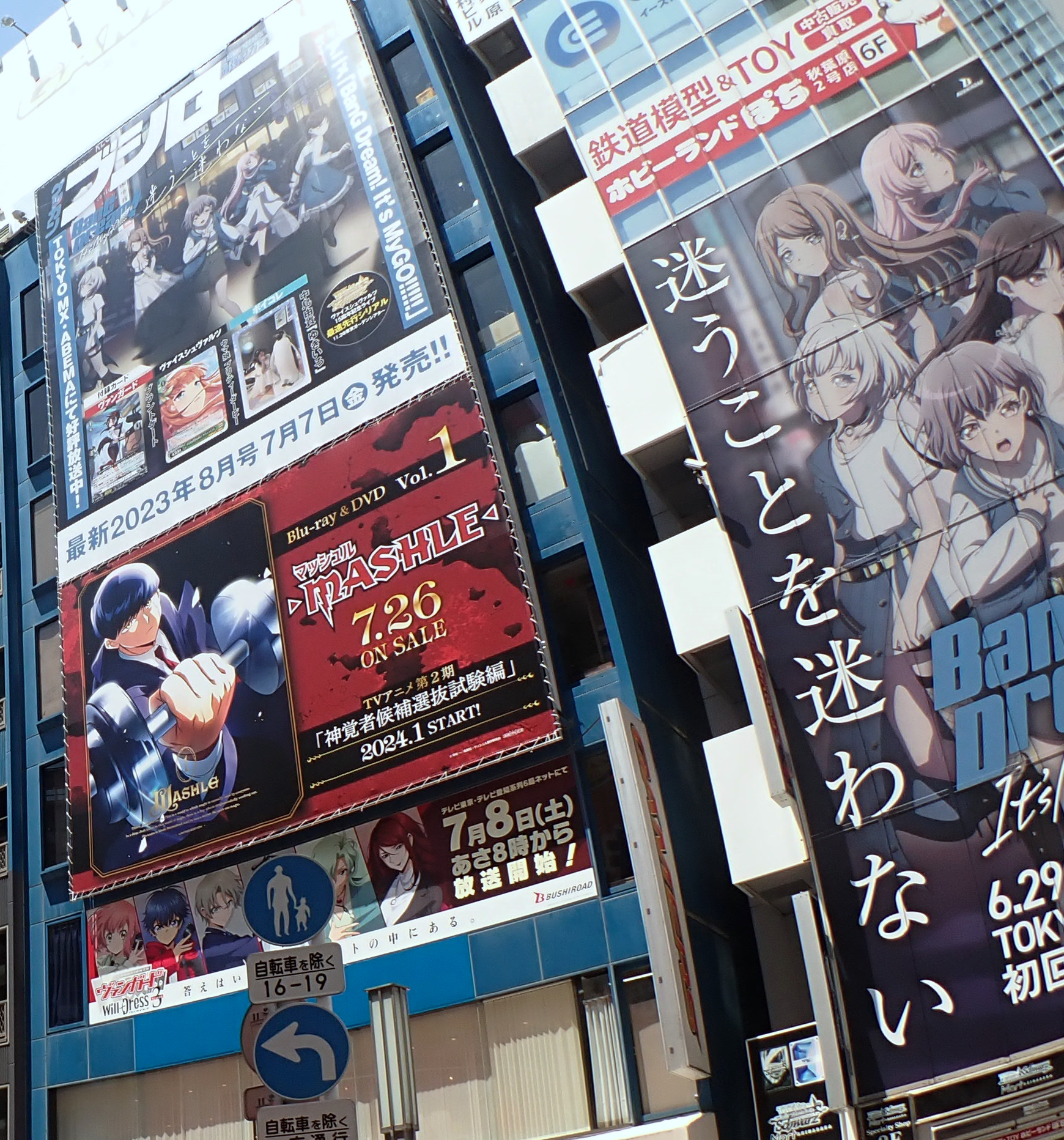
I hate advertising. Until the advertisement is for something I like. And then I give it a pass.
I love Hatsune Miku. I love her so much that I’m willing to forgive her complicity in helping Sega take all my money.
I mean, let’s be real, commercialism and consumerism is baked into moe shit. where are you, as an otaku in this accursed world, if you don’t forgive your favorite girls for running your wallet dry, or, making you feel that FOMO guilt if you didn’t have a wallet to dry, as the case may be.
so:
with that, now I’m gonna talk about how I think the movie succeeds as a promotional vehicle! My super special amazing insight on that based on my expert analysis is, uh…
I don’t know.
I’m not really a business person. If I was, I wouldn’t have spent five years trying to make a living off of YouTube. But I can guess, I guess.
It’s not a mystery who this movie is targeting. It’s targeting the people who are already fans of Miku, and of the Miku phone game. That’s very much it’s primary goal; to make money by positioning itself as required viewing for people who play the game. This is obvious both from the way that the movie itself is paced and structured with no interest in accommodating the uninitiated, and also from the most significant, and almost certainly most internationally challenging, element of its promotion- these fucking postcards.

The commemorative postcards, which were distributed to theatergoers in Japan, the US, and Mexico, contain serial codes to unlock special exclusive content in the game. In Japan, the associated in-game event was launched right alongside the movie. Globally, though, there was lag. The movie came out, people have their cards and codes, and then it took like, I think a week or so for the relevant content and the login campaign and whatever to actually get implemented in the game. And, before that, the US release of the movie itself was scheduled for April 11th, but then was delayed by a week.
They didn’t say it, but it was obvious why. They needed a little extra time to sort out distributing those damn cards with their serial codes. Canada gets the movie on May 11th, and they don’t get the cards. They just get the movie. If any Canadians want the exclusive movie content, apparently they just have to pay for it in the game, buy the 2000 paid crystals for it, whenever that’s enabled. Or, y’know, go get a code from someone giving them away or scalping them.
This speaks to the discrepancy between the market interests and promotional practices of the domestic owners and the international licensors, and how it proves troublesome when it comes to media mix projects like this. The domestic owners of the thing, they’re trying to sell the whole franchise and all the associated products and media and such and so on. But the international licensors, they’re just trying to sell the one thing, and they aren’t necessarily prepared with the infrastructure to mirror the cross-corporate coordination required to like, localize the whole experience. So, yeah, I can imagine it was probably a headache just trying to get it to kind of function.
It does seem like it was a success, though. It made just about as much money in its big weekend out here as it did in the same amount of time when it opened in Japan. The screening we went to was pretty packed; when we walked into the theater there was a Miku cosplayer just kinda hanging out in the lobby, and, yeah. Miku’s an extremely popular cultural icon, and gacha games sure are good at getting people to do things to stay caught up on content and trinkets. You had to see the movie or else you weren’t gonna get the exclusive limited Sekai where Miku chills out after the end of the movie and says a bunch of things about stuff that happened in it. And, y’know, that dialogue was cute and everything, but I was kind of thinking the whole time… wow, I sure would be feeling left out right now if I hadn’t seen the movie. Or if I didn’t live in the US, y’know, the English speaking territory that got it first.
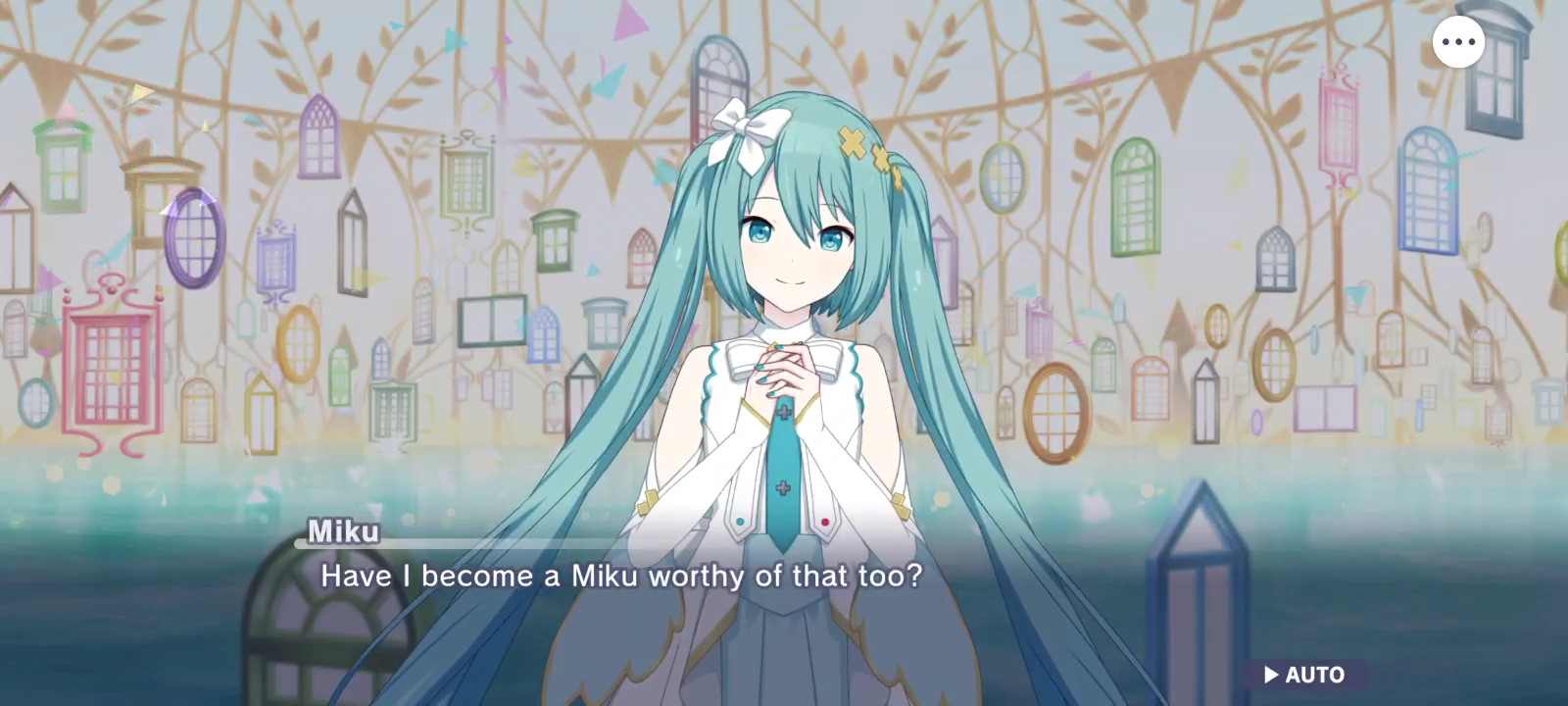
Still, people showed up to the movie, people got their cards, mostly. I got two cards because our girlfriend doesn’t care. I didn’t get a third card from the second viewing, but I did email GKIDS support about it and got a third game content code for my trouble, so, yeah. They very pointedly noted in the form email that they sent, “we are not equipped to mail you a card,” which, yeah. Seems like they handled it about as functionally as they could’ve done.
And. I guess that’s about it?
I think.
I mean they could’ve made more money on the Hatsune Miku movie by, like, advertising it more, but that can be said about most anime movies that get screened here. They could probably be making more money on a lot of things, but whatever. I kinda hope they screen it again because I would like to see it again, because I liked it, and I will probably buy it at some point when it’s on Blu-ray, assuming that it is, like, still possible to buy Blu-rays when that happens. I guess it’s good that it made money, but it making money or not was never my problem, and I only really care about the money insofar as it’s relevant to the potential enabling of the continued existence of the thing I like.

I was gonna write a whole bit about having a fictive of Mafuyu in our brain and watching this movie while she exists, but, y’know what, that’s an essay for some other time. The plural system update essay. We’ve been thinking about that a lot and how to do that, and that’s just, something we’ll do later, when maybe our brain kind of works.
So, I hope y’all enjoyed this whole, thought dump about the Miku movie.
hopefully I finished it just in time for my Canadian bluesky mutuals to go and see the Miku movie and then read about my opinion when they get home.
thanks for reading.
bye
Considering donating to our Patreon or Ko-fi if you would like to support us! patron names:
Ada. Just Ada ★ Anime Omelette ★ ASabitsukiFlow ★ Azu ★ ColorfulCast ★ dameDiadora ★ deeso ★ Duskpixie ★ Elvenoob ★ Emma ★ Gwen Starlight ★ hev ★ Hoshiko ★ Korin ★ L Tantivy ★ LaLaLacuna ★ Lilly ★ M ★ Mira Yeuden ★ Nik Gothic ★ Pigeon ★ Roger C Walker ★ RukaCollie ★ Saoirse Russell ★ Scimitar ★ SleepySlug ★ Spiderrebelnews ★ Thijs ★ Trucy ★ weirdlain
